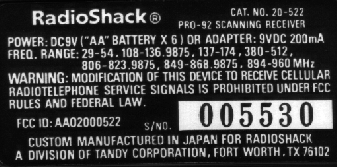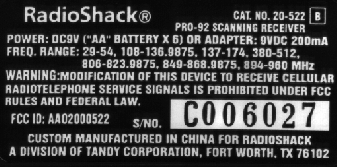The New Year is a good opportunity review some of the material covered in previous columns, and recent electronic mail message I received is representative of many questions beginning listeners have about scanners and trunking systems.
Subject: scanner information.
Hi Dan,
I would like some information on trunking scanners. For one thing, which is the best: the BC245XLT or the Radio Shack Pro-92? They each receive Motorola type I and II as well as EDACS systems, however one has to be better than the other. Also, can you tell me the difference in the trunking systems SMARTNET, PRIVACY PLUS, also AEGIS, ASTRO, ESAS, and LTR. What in the world is all of this. Please help me if you can.
Thank you.
Bob
Determining a "better" scanner is like determining a better car -- it depends on a lot of subjective factors. Different people have different needs and requirements, so the short answer is, it depends.
Uniden BC245XLT
The BC245XLT is a second generation handheld trunk-tracking scanner made by Uniden. It tracks Motorola and EDACS systems, but does not follow LTR. It has memory for 300 channels and includes a computer interface. The protocol used by the interface is available to the public and several individuals have written free utilities that allow a computer to control the operation of the scanner.
The receiver itself appears to be a solid performer, with good sensitivity and solid trunk tracking capability. Reports from users are generally positive, with the exception of complaints regarding a confusing user manual. With so many features and capabilities, it's not easy to explain everything clearly!
Radio Shack PRO-92
The PRO-92 is a trunk-tracking scanner built by GRE and sold by Radio Shack. It has the capability of tracking Motorola, EDACS, and LTR systems. It also has Specific Area Message Encoding (SAME) weather support and other conventional scanning features.
There are currently three different types of PRO-92 scanners out there, which has been the subject of some controversy. The original unit, first available in late 1999, uses sub-audible tones in the voice channel to track trunked systems. Although many users were happy with the scanner, there were a number of reported problems related to large, very busy Motorola systems. There were also problems with the displayed talkgroup ID changing when signal reception was weak.
All trunk-tracking scanners are controlled by an internal microprocessor. The software that instructs the microprocessor what to do is called firmware, and each release of firmware has an associated version number. The original PRO-92 has a firmware version of 1.00 and follows Motorola systems using information in the voice channel called "low speed handshake." This method works well in many environments and is the only way to track LTR.

Last summer Radio Shack introduced the PRO-92A, an "enhanced" scanner that replaced the low speed handshake of the original model with a control channel decoder to track Motorola systems. This is the same method used by Uniden trunk-tracking scanners, and improves performance on many larger Motorola systems. These units may be identified by looking for an "A" in the upper right corner of back label, or by confirming that the firmware version is 3.25.
Just a couple of months later yet a third variant appeared. The PRO-92B is nearly identical to the PRO-92A, except that it's manufactured in China instead of Japan and there's a minor change to the SAME messages. This variant has a "B" in the upper right corner of the back label and the firmware version is 3.28.

All versions of the PRO-92 appear to track EDACS systems equally well. There are reportedly changes to later firmware versions to improve LTR trunking.
| Catalog Number | Date Code | Firmware |
| 20-522 | 07A99 to 04A00 | 1.00 |
| 20-522 A | 05A00 and 06A00 | 3.25 |
| 20-522 B | 07A00 and following | 3.28 |
I bought a PRO-92B last November at my local Radio Shack, on sale for $199. It was an interesting experience because there were three different versions all in stock at the same time. The sales person was not aware of the differences, but was kind enough to let me swap battery packs and check the firmware version.
You can check the version yourself by turning the scanner on and pressing the '3' key while the Welcome to Multi-System Trunking appears. My original PRO-92 from 1999 displays Version 1.00 while the one I just purchased shows Version 3.28.
Smartnet
Smartnet refers to a Motorola analog trunking system. Scanner listeners often refer to these systems as Type II, and they can be tracked with almost any trunking scanner. There is also a second-generation product from Motorola called Smartnet II.
A Smartnet system may have as many as 28 channels, up to four of which are usually assigned as control channels. Since the control channel is transmitted continuously (100% duty cycle), it is typically changed each day to reduce the wear and tear on the transmitter and antenna components.
Smartnet systems are organized by talkgroup, and can support more than 48,000 individual radio IDs and 4,000 talkgroups. Frequency and talkgroup assignments for specific cities and agencies are available in printed form and on the Internet.
Motorola radios are typically capable of dual-mode operation, meaning they can work through either trunked or conventional repeaters. These radios can also operate talk-around, meaning they can transmit and receive directly with other mobiles on a single frequency without needing a repeater.
Smartnet transmissions have different priority levels, with emergency being the highest.
In case of repeater failure, Smartnet supports a mode called failsoft. Each mobile radio is assigned a voice channel and will tune to it when a sub-audible fail-safe tone is present. The radio then operates in conventional mode. This feature made the news last fall on election night, when the new Nashville Metro system in Tennessee went into failsoft for about 30 minutes, leaving police and fire crews out of contact just before the War Memorial Plaza was to be opened to the public.
You may also hear about Smartzone, which is an enhanced version of Smartnet. Smartzone is basically a network of Smartnet systems all tied together. When a mobile is turned on or drives into the coverage area of a new repeater site, it transmits its ID and talkgroup affiliation to a zone controller. This registration allows the zone controller to know where all members of a talkgroup are located. Calls for a talkgroup are then transmitted only from the repeater sites that have registered users in that talkgroup.
Privacy Plus
Privacy Plus is a Motorola marketing name for their older Type I trunking system. The "Privacy" refers to an improvement over conventional systems, where anyone with a radio could potentially hear every call. Privacy Plus radios won't complete the audio path to the speaker if the radio isn't programmed to be part of the transmission.
From a user point of view, Privacy Plus radios work the same way as Smartnet radios except that Privacy Plus radios don't have emergency call or dynamic regrouping capability, and they cannot automatically switch between systems.
AEGIS
Technological advances are also affecting radio systems. The current trend is a transition from the older analog systems to new digital networks. AEGIS is Ericsson's first generation digital system, first offered as an upgrade to EDACS in 1993.
AEGIS, like other digital voice systems, takes the analog microphone input and digitizes it using a vocoder (voice encoder/decoder). The resulting data stream is further encoded with error correction information before transmission.
AEGIS users tend to be police detectives and medical personnel, giving them somewhat more privacy.
AEGIS is a closed, proprietary protocol, and I am not aware of any commonly available decoders for the system. Trunking scanners will not follow AEGIS transmissions, and listening to the channel in conventional mode will result in hearing digital data bursts.
ASTRO
ASTRO is another Motorola marketing term for their digital two-way radio products. These radios can use the same trunking signals as analog units, but transmit and receive voice signals in digital format. Because most ASTRO systems use the older 3600-baud control channel format, trunking scanners can usually follow the transmissions and display the talkgroup IDs. However, the voice portion is digital so the scanner won't be able to deliver the audio. It is possible to run both analog and digital radios on the same system.
ASTRO is slowly migrating to the APCO Project 25 family of digital radio standards, including the Common Air Interface (CAI). More information about Project 25 can be found in the July 2000 Tracking the Trunks column and on my website.
Logic Trunked Radio (LTR)
E.F. Johnson developed Logic Trunked Radio (LTR) as a simple, multi-channel mobile radio system, one step up from a conventional repeater. LTR was covered in detail in the May 2000 Tracking the Trunks column.
LTR does not use a dedicated control channel; instead each channel includes a sub-audible data stream that identifies the current talkgroup assignment. Because there is no control channel, each radio is assigned a "home" channel that it tunes to when it is in standby mode.
A repeater base station is made up of one or more channels, and each channel can support up to 250 identifiers. These IDs may be assigned to talk groups or to individual radios.
Currently, the PRO-92 handheld and the PRO-2067 mobile scanners support LTR trunk tracking.
Extended Sub-Audible Signaling (ESAS)
Uniden has an enhanced LTR protocol called Extended Sub-Audible Signaling (ESAS) that provides automatic, wide-area networking, voice mail, and individual unit paging. It allows radios to be uniquely identified and allows "roaming" between different LTR systems.
That's all for this month. As always, I welcome electronic mail at dan@signalharbor.com and you can find more information about radio topics on my website at www.signalharbor.com. Until next month, happy monitoring!